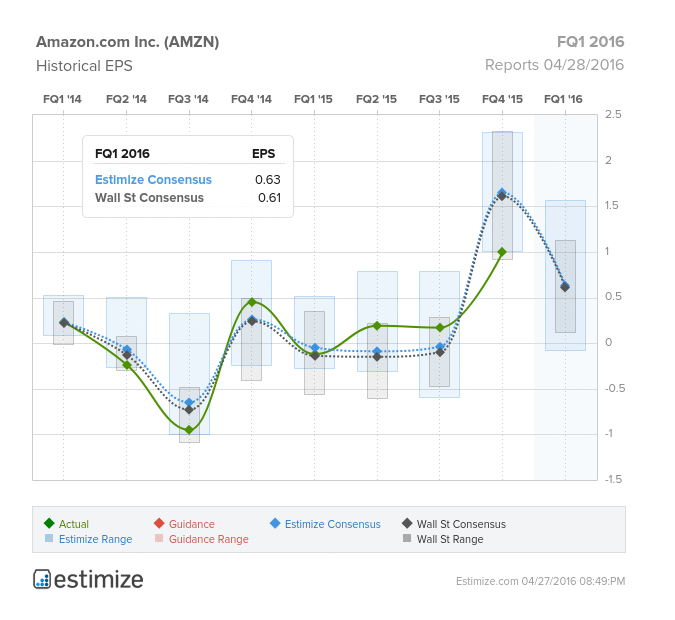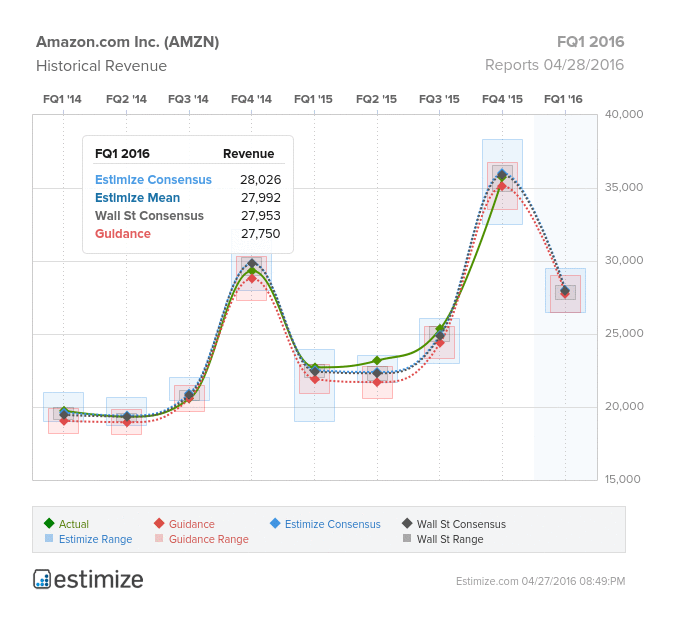Amazon.com Inc (NASDAQ:AMZN)
Consumer Discretionary - Internet and Catalog Retail | Reports April 28, After Market Closes.
Key Takeaway
- The Estimize consensus is looking for earnings per share of $0.63 on $28.02 billion in revenue, 2 cents higher than Wall Street on the bottom line and $70 million on top
- Amazon Web Services is currently Amazon’s most profitable sector and represents about 30% of the entire cloud computing market
- During the past 2 years, Amazon Prime memberships have nearly doubled, up to 54 million, and almost half of all adults in the U.S. have Prime subscriptions
Amazon caps things off for FANG this quarter with Q1 earnings tomorrow after the bell. Expectations this quarter are just as lofty as they have been in the past as earnings per share estimates have climbed 26% since Amazon’s last report. The Estimize consensus is looking for earnings per share of $0.63 on $28.02 billion in revenue, 2 cents higher than Wall Street on the bottom line and $70 million on top. Compared to a year earlier, profits are forecasted to increase a resounding 620% while sales could rise as much as 25%. Given Amazon’s sheer size it’s not surprising that the stock remains relatively flat during earnings season. In the day prior shares increase on average by 2% which is the biggest movement Amazon typically sees during this time.
After continually being scrutinized for posting losses, Amazon is coming off three straight quarters of profitability. Amazon Prime and the dominance of Amazon Web Services (AWS) is expected to carry the retailer in 2016. During the past 2 years, Amazon Prime memberships have nearly doubled, up to 54 million, and almost half of all adults in the U.S. have Prime subscriptions. In fact, a quarter of all active Amazon shoppers are Prime members. In hopes of converting more customers to Prime, Amazon raised the minimum order total for free shipping for non-Prime members to $49 from $35 earlier this year.
On the other hand, AWS is currently leading in the cloud infrastructure industry, representing about 30% of the market. In recent years, large enterprises such as Netflix (NASDAQ:NFLX) have migrated to AWS to be its platform provider which validates their credibility and reliability. In addition, Amazon has begun expanding its web services in five new regions this year, including China, India, and the U.K. Heavy investments in global expansion on top of Google (NASDAQ:GOOGL) and Microsoft Corporation (NASDAQ:MSFT)'s ascension in cloud computing will put pressure on Amazon’s margins. On the bright side the expected growth in cloud computing and Internet of Things (IoT) should support an optimistic outlook as Amazon continues to expand its web services.


